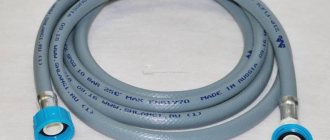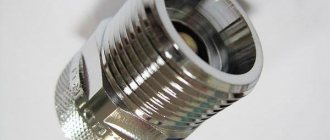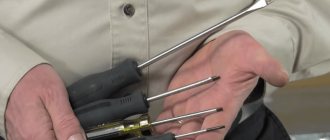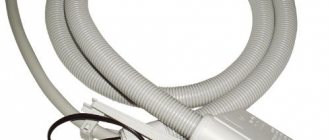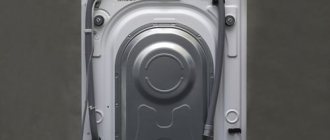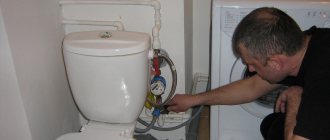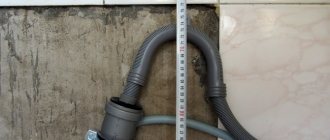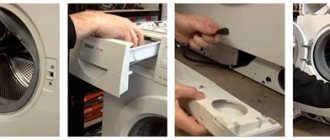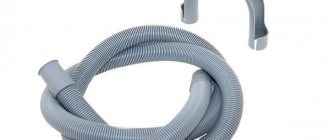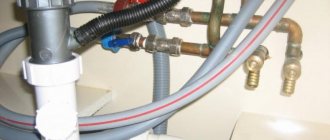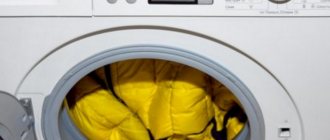Household appliances of this type have long become an indispensable attribute for most households. Purchasing and connecting washing machines to sewerage and water supply has long become commonplace and most of us know how it’s done.
However, in this article we will dwell on the issue in detail and analyze all the nuances of connecting to water supply and sewerage, what methods exist, what tools and materials we will need, and how to avoid common mistakes.
But first, let's briefly learn how to connect a washing machine: the hose for connecting cold water is screwed at one end to the water pipe, and the other to the filler fitting of the machine. The end of the drain hose at a certain height is connected to the sewer system. Below, we will look at all the processes in more detail.
Functions and types of hoses
Unlike the water hose on the drain arm, the main function is to discharge contaminated wastewater into the drain when the machine is running. The price for them can vary from 50 to 600 rubles, depending on the variety and length.
Hoses can be of 3 types:
A regular fixed length hose, which can vary from 1 to 5 meters, is standard, but can be extended if necessary by connecting two drains together using clamps.- Universal telescopic hose. It is sold in compressed form as a result of 60 cm can result in a sleeve length of 2 meters. You don’t have to worry about how to extend the drain hose of your washing machine. But such hoses have their drawbacks. They are more prone to clogging, they vibrate more when draining water due to corrugation. In addition, the sleeves must be pulled smoothly, otherwise there is a danger of damaging parts of them during sudden movements.
- The sleeve in the compartment is very convenient due to the fact that you can make the desired length yourself, inside the module. There are notches on the hose where you can cut it; the module is usually 50-55 cm long.
But using drain hoses that are too long is not recommended as it increases the risk of blockages. Possible formation of stagnant zones and even complete blocking of the hose, which can lead to malfunction in the machine. In addition, a hose that is too long is more likely to be damaged and deformed.
Drain hoses for washing machines and dishwashers are often universal; they are made of gray polypropylene. At the ends there are fittings with a diameter of 19 and 22 mm, made of elastic rubber. One end of the hose from the washing machine is connected to the sewer, and the other to the device. If necessary, drain the water into a sink or bathtub. But you need to remember how to extend the inlet hose of a washing machine.
Reviews from our clients
Anastasia
The Samsung washing machine has stopped draining water. The called technician arrived on time and brought a replacement part with him. The repair took about an hour. I'm happy with the result.
Andrey
The drum in the washing machine stopped spinning and called a technician. After replacing several parts, the machine operates as usual.
Valya
I contacted the company after the machine started freezing during the spin phase. The technician who arrived said that it was a program failure. The problem was fixed and a warranty was provided.
Svetlana
The drain hose came off during washing. She quickly turned off the washing machine and called a technician. The specialist arrived with the necessary spare parts, the repair took 20 minutes. Everything works, thank you!
Valeria
The lights were flashing, the hatch door did not open, the programs did not start. They said that the problem was most likely in the electronic module. After replacement, the machine works, thanks to the master!
Grade
Options for creating a drain for washing equipment
The washing machine uses tap water in its operation, which must be drained after washing. To do this, each device is often equipped with a special hose, which sometimes needs to be replaced. Connecting equipment to the water supply system and replacing hoses usually does not cause problems. For these purposes, use the hose that comes with the washing machine, possibly an extension. It is connected to a water tap. It is also important to know how to extend the water supply hose of a washing machine.
There are two ways to organize the release of a washing machine into the sewer:
- Temporary drain. With this method, the drain hose is simply attached to the edge of the sink or bathtub while the washing machine is running.
- Constant drain. In this case, the hose is connected directly to the sewer system. The device includes a curved plastic guide for this purpose. It is inserted and hung on the wall, and water does not flow out of the machine due to pressure.
Connecting washing machines to the water supply - several connection methods
Watch the video - the first method of establishing a connection to the water supply
How to install a washing machine, connecting the washing machine to the water supply. Video tutorial Plumber
The sales package for such a unit always includes a hose for connecting cold water. Its length is 1.2-1.5 meters and at the ends the hose is equipped with two union nuts made of plastic.
One of the ends is installed on the hose at a right angle. It must be installed on the inlet of the unit. The installation angle prevents the hose from kinking or pinching. Connection is made in the following order:
- Turn off the water supply to the water supply by turning off the tap on the riser.
- Unscrew the flexible cold water line at the sink or sink.
- Install the tee onto the supply pipe in the water supply system so that the side outlet is located conveniently for connecting the washing machine hose.
- Screw the filling hose to the tee. When tightening the plastic nut, do not use a tool, and only tighten the nut until it stops by hand. Tool installation often results in breakage of the flimsy plastic nut.
- Install the flexible mixer hose.
A test supply of water to the system with the washing machine should be carried out with the tap on the crosspiece closed, and only after making sure that there are no leaks can it be opened to check the reliability of the hose connection.
This connection option is used when the installation location of the unit coincides with the location of the sink or sink.
Otherwise, you need to bring the water closer to it. To do this, a tee is inserted into the nearest water pipe.
An additional pipe of the water supply system is extended to the installation site of the washing machine, where it is connected in the manner described above.
Often, filling the household with household appliances occurs gradually; eventually, under the sink or sink, the entire space is filled with tees and a tangle of various hoses.
How to connect a washing machine (review video)
Providing for this possibility, a manifold with several outlets is installed on the embedded pipe. An output that is not currently in use can be closed with a plug and used at the right time.
Removing shipping parts
After the washer is unpacked, you need to check and remove all transport parts that provide rigid fixation of the tank and other rotating parts, which are thus protected from damage during transport.
These parts will be bolts, holders, rods and brackets that need to be disconnected. It should be noted that if the machine is turned on before the shipping parts have been removed, this may cause irreversible damage and may cause the machine to fail.
The main type of transport parts are bolts. With their help, the tank is fixed, which, after unscrewing, should hang on springs. This is the normal operating condition of the tank. These holes, which remain after the bolts are removed, are usually plugged by the plastic plugs supplied with the kit.
The brackets provide additional rigidity for transportation, and they also help secure the power cord and drain. Sometimes additional transport beams are placed between the tank and the body, which can be removed after the machine is tilted slightly forward.
These transport parts that you removed should actually be stored in case of moving the machine to a service center, to a new apartment or cottage, they should be mounted back to avoid damage to the machine during transportation.
The correct procedure for removing shipping parts can be found in the owner's manual that came with your machine.
Connecting equipment to the electrical network
The most important condition for the operation of the machine is its safety during operation. And the correct connection of the machine to the electrical network is the most important point to ensure this. The following rules must be strictly followed:
- A three-wire electrical outlet must be installed at the installation site.
- Grounding must be installed.
- The ground wire must be reliably insulated.
- If the machine's power cord is not long enough to connect to the mains, use a grounded extension cord.
- Do not connect the grounding cable to radiators or water and gas pipeline systems - this is dangerous to life!
If you do not have special training and do not know what to do with your own power supply, it is better to invite the electricians who service your home. They will carry out the wiring that supplies all powerful home appliances with high quality and safety regulations. But be prepared for the fact that such work will not be quick.
Machine installation process
To install washing equipment, you need to connect it not only to the electrical network, but also to water supply and sewerage.
A new machine should have instructions or a diagram with a step-by-step description of installation. Even if the owner of the washing machine has experience in installing the machine’s hose device, it is still necessary to carefully read the instructions, which describe in detail the installation of each drain hose. As a result of incorrect installation of the machine drain, water leakage and destruction of the mechanism may occur, and negative consequences may occur.
Required tools and materials:
- FUM.
- Hoses.
- Siphon.
- Double hose for draining into the sewer.
- Double water supply hose.
- Electric drill.
If the required length of the drain hose is not available, it can be increased, but incorrect and unreliable extension can lead to flooding of the apartment. It is better to purchase a hose that has the required length.
You can drain water from the plastic sleeve of the equipment into the sewer system if this function is provided by fixing the pipe located on the side of the sink or bathtub.
If the drain hose is to be installed in the bathtub, it is necessary to ensure that the water drains properly. It is this discharge of water during operation of the washing machine that will prevent flooding in the room if the drain hose accidentally falls out of the structure.
The drainage hose is installed on the back wall of the washing machine at a height of about 80 centimeters from the end, which should not interfere with the drainage. You can use another siphon.
From the second end of the hose, you need to start connecting using the main siphon, which prevents the entry of odor from the wastewater. This may require bending the drain hose in addition to creating a water dam effect, but not preventing the leak, to prevent odors from entering the machine.
To connect the hose in the machine, there is a limit on the height of the outlet nozzle, minimum and maximum. To ensure high quality drainage and prevent flooding of the apartment through the machine as a result of a clogged sewer pipe, it will be necessary to leave an air gap. In this case, when washing, water will not flow into the sewer from the equipment, and the installed program will begin to work incorrectly. Here you need to take into account the level of rise of all the water in the bathtub or sink, which should be slightly lower, and the gap should be higher.
How to extend the drain hose?
Step-by-step instruction:
1. Place a clamp on the end switch, then attach it to one side of the fitting.
2. Do the same on the side of the extension cord.
3. Tighten the clamps.
4. Attach the extension to the sewer pipe or drain siphon.
5. Start test mode.
See how simple it is? Shopping took longer than the process itself. This trick can also be done from the side of the inlet hose if the water pipe is located far enough away.
Another and third installation method
The second method is suitable if the mixer and water supply are connected using a flexible reinforced hose, in the gap of which a water tap is installed, namely a tee, as well as a water supply. In this case, the tap will not affect the flow of water to the kitchen faucet, but will ensure that the flow of water only to the machine is blocked. It is necessary to use a structure similar to the first method.
The use of the third method is typical for the presence of metal-plastic pipes. Here you need a special tee or fitting. A cut is made on metal-plastic pipes, and a fitting, which is equipped with a tap, is inserted into it. The tee kit comes with all the parts needed to seal the unit.
Connection is carried out according to the instructions . The diameter of the washing machine drain hose is about 34 inches. Once the machine is turned off, the water flow is required to be blocked, so an additional valve must be installed to shut off the water supply. To clean the water entering your machine from small contaminants that clog the equipment as a result of being supplied through the water supply, use a strainer. It's right behind the valve. Removal and special cleaning are required from time to time.
Regardless of the chosen method of connecting the drain to the sewer, immediately after completing all work, perform tests and lay down the laundry. Then you will immediately see possible shortcomings . If everything is done correctly, the drain system will work as long as the washing machine itself. In case of problems, you need to know how to change the drain hose in a washing machine.
Materials and tools for connecting to water supply and sewerage
The need for certain materials when installing and connecting washing machines to sewerage and water supply is determined, first of all, by the location of the unit and the accessibility of the designated objects. In some cases, it is necessary to incur significantly higher costs in order to subsequently use household appliances conveniently for many years.
If you plan to lay additional branches from the water supply in the groove, you will need a fairly powerful angle grinder with a saw blade for concrete. You can use a hammer and a chisel to break out the concrete.
A pipe without joints is laid in the groove to ensure its long-term operation without leakage. Otherwise, if a leak occurs, restoring the functionality of the pipe will involve a large amount of troubleshooting work.
To connect to the water supply network, a tee with a shut-off valve is usually used, and to install it in place, a set of wrenches or a universal adjustable wrench is used. All threaded connections are sealed with tow or FUM tape.
Installing an external pipe involves attaching the pipe to the wall; for this you will need an electric drill and concrete drills. Plastic dowels are installed in the drilled holes, fastening is carried out with screws of the appropriate size.
When installing washing machines, the main requirement is that the top cover is horizontal in relation to the floor. For precise installation of the washing machine, a building level is used; adjustment is made using screw support legs.
To arrange a drain for washing machines into the sewer, you will need a drain adapter with an outlet at an angle of 45 degrees.
To connect washing machines to electricity, you will need a three-core cable with a cross-section of 2.5 square meters in double insulation and a 16-amp diffusion machine with a leakage current of no more than 30 milliamps.
In addition, it is possible to use control equipment - a voltmeter. Let’s take a closer look at how to properly connect the washing machine to the mains below.
